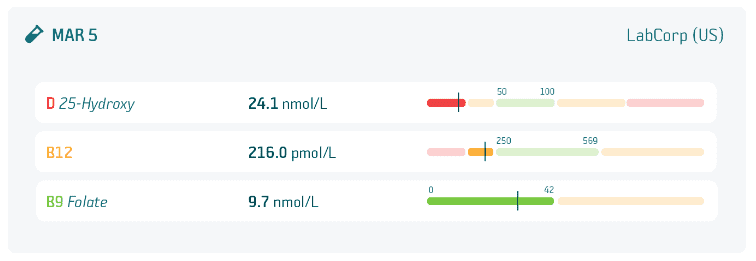
Blood test ranges, units and interpreting results
The information presented here does not constitute medical advice, and is not intended to be a substitute for a consultation with your medical doctor. If you have a concern about your health it is important that you talk with your physician so that all important information, such as age, ethnicity, health history, signs and symptoms, laboratory and other procedures (radiology, endoscopy, etc.), can be taken into consideration.
You’re taking regular blood tests, and tracking results over time. Then one day, you notice a sudden change for one of the biomarkers. Should you be concerned?
The answer depends on the particular biomarker. For some, a borderline result makes no difference. For others, it may be an indication of potential health risk.
But first, let’s talk about normal ranges…
Blood test reference ranges
When you do a blood test, your lab report will include a normal reference range next to each of your test results.

For example, if your routine blood work includes a test for Vitamin B12 (Cobalamin), your lab may list the reference range as 250 to 569 picomole per liter (pmol/L). If your result is 405 pmol/L, right in the middle, you can feel confident that your B12 level is normal.
Remember that labs in different countries may use different units for the same tests. For example, some labs may report your Vitamin B12 level in pg/mL. Make sure to convert all your results to the same unit, and use a relevant reference range.
Alternatively, you can import your lab reports into Plas.me. The app will convert all your results into the same units, and display easy to read, visual reference ranges for each:

What if a blood test result is at the very low or high end of normal, or even slightly outside the normal range? Is that a red flag?
Keep in mind that results can vary a bit from lab to lab, as do recommended reference ranges.
Minor fluctuations in test results may also reflect:
- fasting
- smoking
- recent infections
- medications
- stress
- exercise
- menstrual cycles
- lab procedures
Normal ranges for each test are established by testing a large population of healthy individuals, and you may be one of the healthy people outside the statistical range. Many people are consistently just above or below normal range, and for them, that’s perfectly healthy.
For example, elite athletes tend to have higher creatinine levels (and as a result, lower Glomerular Filtration Rate (eGFR)) than the general population, and should compare measures to their own baselines, not the reference range.
When to be concerned
For most tests, instead of worrying about a one-time rest result on the edge of the normal range, it is better to look at trends.
If your test result has always been in the high normal range, there is likely no need for concern. A sudden change from years of low normal results to high normal, on the other hand, is important to look at in more detail.
For instance, the normal range for blood sugar (glucose) for non-diabetics is 4-5.9 millimoles per litre. If your test results have always been around 4.5 mmol/L, but the latest result is suddenly 5.5 mmol/L, you may want to ask yourself some questions.
Have I put on weight? Am I eating more carbs and sugar?
Some tests, such as vitamin levels, will likely change a bit over time. Others have no room for fluctuation.
For example, if your levels of liver enzymes — AST (aspartate aminotransferase) and ALT (alanine aminotransferase) — have always been normal, then one of them starts to go up one or two points, there might be something wrong with liver function.
Differences between labs
The accuracy of laboratory testing has improved significantly over the past few decades, but some variability can occur, not just between countries, but also individual labs. This may be due to differences in lab equipment, chemical reagents, and analysis techniques.
Although this isn't always possible, it is recommended that you take consecutive tests at the same lab for best results.
If you have taken a test at a new lab, and your result is radically different from your normal baseline, consult your new lab's reference ranges and consider retaking the test in your former lab.
Conclusion
Even if you feel that you’re healthy, it’s a good idea to have a continuous record of standard blood markers so you and your doctor can look for trends. If you have some results at the high or low end of normal, ask your doctor if you should repeat the test or investigate them further.
